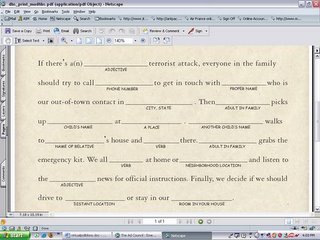Often, it's true that this blog is a rogues' gallery of regrettable or unintentionally humorous things found on government websites. But I also want to pay tribute to some good government sites that serve citizens relatively well and follow many of the principles of information design presented by
Edward Tufte.
So here are my
Top Ten. (And I'm certainly not going to put the confusing official portal
First.gov anywhere on my list or the
Social Security website, which is a nightmare for navigation.)
1.
Factfinder from the
The U.S. Census BureauA researcher's dream! Easy to use and designed for a variety of potential queries, this site exemplifies how information can also resist easy interpretation, as its section on "data sets" acknowledges.
2.
National Aeronautics and Space Administration (NASA)Despite its stupid new "Astronaut Flight Lounge" Flash opening, this site still can't be beat for luscious satellite photos and rover cam shots.
3.
United States Geological SurveySure,
Google Earth is cool, and I've been known to spend hours travelling to Kabul and Pyongyang with it. But your tax dollars bring you this pretty neat, although somewhat buggy tool as well. Check out the
Map Viewer. Fun for looking at recent earthquakes and volcanic activity, while you are at it.
4.
The Internal Revenue ServiceOkay, nobody likes to pay taxes, but this site is a model for what
Jane Fountain has argued was the first priority for creating the Virtual State: access to downloadable forms.
5. The
FBI's Freedom of Information Act Electronic Reading Room
A great source of information about the suspect character of public figures from Gracie Allen to Richard Wright. I have used Bertolt Brecht's file in my own research and have found it invaluable from the standpoint of reception theory.
6.
The Library of CongressThis is is site I've criticized before. And their glorification of Coca Cola advertisements or Yankees posters doesn't make it any easier for me to grapple with obvious gaps in the historical record of
American Memory (like the McCarthy era). But this is a site that I use all the time in teaching students to find interesting visual materials, so it still makes it into my top ten. There is also a lot of good information on legislative history from
THOMAS, but it is so arbitrarily organized as to be almost unreadable.
7.
The National ArchivesA good site for high quality photographic facsimiles of significant
American documents. This site is also greatly improved by regular updating. (For example, today the site features new documents in Samuel A. Alito's Supreme Court Nomination.)
8.
The Supreme CourtIt's a modest site, but it presents information well. Legal terms and procedures are explained. Documents are presented in a logical fashion. Even the architectural details of the building are elaborated upon.
The Senate has a comparatively incoherent site, although the
gallery of busts of Vice Presidents is worth a visit.
9.
Occupational Safety and Health Administration (OSHA)Although it's not as apparent how to file complaints or blow the whistle on government malfeasance as it should be, at least this site allows people to
report safety and health hazards online with some degree of anonymity. (It's easier to find out where to
submit a crime tip on the
FBI site, but it's not anonymous, which is understandable, given the number of crackpot leads.) Much of this site, like the site from the
Department of Labor, still relies on traditional handbooks as modes for distributing information.
10.
The National Science Foundation (NSF),
The National Endowment for the Humanities (NEH),
The National Endowment for the Arts (NEA), and other government funded agencies that support knowledge-building
As sources to locate research funds, government websites also serve an important purpose. So these all tie for 10th place.
(After you are done with this list, you may also want to compare our government to
other governments in the world.)
Labels: government websites













